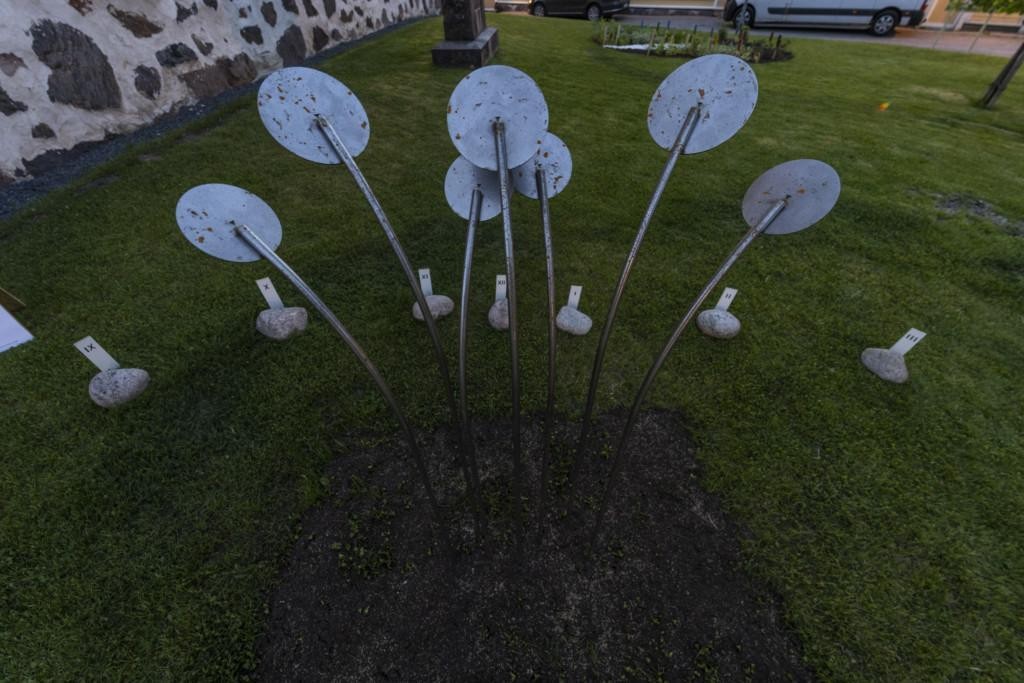Sundial, 2021
Metal, stone.
Välj på svenska från övre höger hörn
Valitse suomeksi oikeasta ylänurkasta
See Oasis map here
The sculptor, conceptual artist and land artist Lauri Anttila’s production includes the creation of nine sundials, one of them for Kaivopuisto Park in Helsinki. His art is based on observation and he is interested in light phenomena that we might normally overlook: sunspots, shadows and camera-obscura effects. He investigates differences and similarities in the ways that art and science are perceived, and seeks to give nature prominence on a sensory, holistic level. His works are often based on those of other visual artists, authors, composers or researchers. Here, he has turned to the astronomer and astrologer Sigfrid Aron Forsius who lived and worked in Ekenäs in the 17th century.
This sundial consists of seven black, metal pointers shaped like a clump of flowers. On the ground in front of the sundial are seven stones. On the tips of the pointers are round plates and inside them triangular openings. These triangles let the sunlight through, but surprisingly enough it is projected onto the ground as a circular shape, the shape of the sun. Anttila points out that similar round, solar formations can be found under the surrounding trees. The time is indicated very precisely when the roundness of the solar image is extra clear, otherwise it can look more like vague blotches. Anttila’s sundial shows seven different hours; each leaf constituting a time of day. All of the pointers show the time more or less as it is, but it is only when the sun is seen as a circle that the time is exact. The arrangement is site-specific, to the extent that it explicitly shows Ekenäs time: the way that Ekenäs is, for example, 6 minutes behind Helsinki local time. Sited beside Forsius’ memorial stone, it is linked to his theories of time and his weather almanacs, and his focus on star signs and the micro/macrocosm. All this highlights the way that our concept of time is totally different from that of the 17th century. A second was hard to measure then. In other words, it was not as precise as it is now, rather, everything was measured more via concrete action.
Lauri Anttila (b. 1938) graduated from Aalto University (then the School of Art and Design) as an interior architect in 1965. The job of interior architect has, however, had to make way for his intense involvement in the visual art arena since the sixties, and also abroad from the 1990s up to the present. He primarily uses sculpture, photography, texts, drawings and installations as his means of expression. Many of his works are based on journeys that he has made in Scandinavia, Germany, Russia, the USA, Canada, and elsewhere. Anttila was Rector of the Academy of Fine Arts, Helsinki, in 1988–1994, a Professor in 1989–2001, and is now Professor Emeritus of the Time and Space Arts subject area, which he founded. He has also taught abroad at art academies in Virginia, Manchester, Reykjavik among others. Anttila is an honorary member of the Ursa Astronomical Association and Association of Finnish Sculptors. In 2019, he took part in Kiasma’s Coexistence exhibition and in the Ateneum’s exhibition Finnish Artists in Ruovesi. In 2014, he showed solo at Ama Gallery and, in 2019, together with Corinna Helenelund at Galleria Sculptor, both in Helsinki. Anttila has made numerous public works, most of the sundials during the 2000s, for example, in Oulu, Vantaa and Vuosaari.
Photo: Tähdet ja Avaruus, Otto Laosmaa


